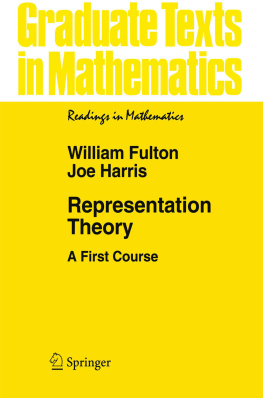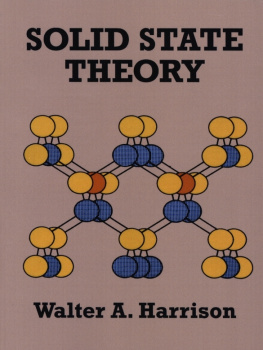Stewart Harris - An Introduction to the Theory of the Boltzmann Equation
Here you can read online Stewart Harris - An Introduction to the Theory of the Boltzmann Equation full text of the book (entire story) in english for free. Download pdf and epub, get meaning, cover and reviews about this ebook. year: 2012, publisher: Dover Publications, genre: Home and family. Description of the work, (preface) as well as reviews are available. Best literature library LitArk.com created for fans of good reading and offers a wide selection of genres:
Romance novel
Science fiction
Adventure
Detective
Science
History
Home and family
Prose
Art
Politics
Computer
Non-fiction
Religion
Business
Children
Humor
Choose a favorite category and find really read worthwhile books. Enjoy immersion in the world of imagination, feel the emotions of the characters or learn something new for yourself, make an fascinating discovery.
- Book:An Introduction to the Theory of the Boltzmann Equation
- Author:
- Publisher:Dover Publications
- Genre:
- Year:2012
- Rating:4 / 5
- Favourites:Add to favourites
- Your mark:
- 80
- 1
- 2
- 3
- 4
- 5
An Introduction to the Theory of the Boltzmann Equation: summary, description and annotation
We offer to read an annotation, description, summary or preface (depends on what the author of the book "An Introduction to the Theory of the Boltzmann Equation" wrote himself). If you haven't found the necessary information about the book — write in the comments, we will try to find it.
An Introduction to the Theory of the Boltzmann Equation — read online for free the complete book (whole text) full work
Below is the text of the book, divided by pages. System saving the place of the last page read, allows you to conveniently read the book "An Introduction to the Theory of the Boltzmann Equation" online for free, without having to search again every time where you left off. Put a bookmark, and you can go to the page where you finished reading at any time.
Font size:
Interval:
Bookmark:
S TEWART H ARRIS (19372004) was a faculty member in the Department of Mechanical Engineering at Stony Brook University from 1966 until his death. He served as chairman of the department from 1978 to 1981 and was the dean of the College of Engineering from 1981 to 1992. Professor Harris held many visiting appointments in the U.S. and in Europe; these included positions at Princeton University, Imperial College (London), the Materials Directorate at Wright Patterson Air Force Base, and Columbia University.
Dr. Harris received a B.S.E. from Case Institute of Technology (1959) and an M.S. (1960) and Ph.D. (1964) from Northwestern University, followed by postdoctoral work at the Courant Institute from 1964 to 1966. His research focused on the theory of transport processes at the microscopic level and on molecular beam epitaxythe growth of atomically precise metal and semiconductor crystal structures. Dr. Harriss research interests encompassed a number of distinct areas related to the study of reaction-diffusion systems; most recently these included the dispersal of genes and organisms, including early human populations.
A N I NTRODUCTION
TO THE T HEORY OF THE
BOLTZMANN
EQUATION
Stewart Harris
State University of New York
at Stony Brook
Dover Publications, Inc.
Mineola, New York
Copyright
Copyright 1971 by Holt, Rinehart and Winston, Inc.
Copyright renewed 1999 by Stewart Harris
All rights reserved.
Bibliographical Note
This Dover edition, first published in 2004, is an unabridged republication of the work originally published by Holt, Rinehart and Winston, Inc., New York, in 1971.
Library of Congress Cataloging-in-Publication Data
Harris, Stewart.
An introduction to the theory of the Boltzmann equation / Stewart Harris. p. cm.
Originally published: New York : Holt, Rinehart, and Winston, 1971.
Includes bibliographical references and index.
ISBN 0-486-43831-7 (pbk.)
1. Transport theory. I. Title.
QC175.2.H33 2004
530.138dc22
2004050198
Manufactured in the United States of America
Dover Publications, Inc., 31 East 2nd Street, Mineola, N.Y. 11501
43831702
To My Parents, Seymour and Goldie
And My Wife, Helen
Faith is a fine invention
For gentlemen who see;
But microscopes are prudent
In an emergency!
Emily Dickinson
Preface
The past twenty years have seen the steady maturation of the theory of the Boltzmann equation. In this period the Boltzmann equation has gone from a rather formidable mathematical curiosity with a limited but distinguished following, to a much used methodology having widespread application. With the advent of modern high-speed flight through the rarefied regions of the outer atmosphere Boltzmann's equation has taken on a particular practical significance. However, it is no longer the exclusive property of the fluid physicist. One finds Boltzmanns equation, or Boltzmann-like equations, extensively used in such disparate fields as laser scattering, solid-state physics, nuclear transport, and even outside the conventional boundaries of physics and engineering in the fields of cellular proliferation and automobile traffic flow. It is especially significant that at a time when the method of time correlation functions seemed to be usurping much of the Boltzmann equations earlier domain of transport theory such a veritable cornucopia of new uses for this equation should arise.
Many of the advances which have been made in the theory of Boltzmanns equation since the publishing, some thirty years ago, of Chapman and Cowlings now classic monograph are contained in the Handbuch article of Grad, who is himself responsible for much of this work. There exist two other outstanding expositions on the theory of the Boltzmann equation, the book by Carleman, and the Handbuch article by Waldmannneither, unfortunately, are at present available in English. The above-mentioned sources are intended for a relatively sophisticated audience and for that reason are not basically suitable for use as a text in an introductory graduate level course on the theory of Boltzmanns equation; in fact, strangely enough, there seems to be no book at the present time which satisfies this need. (Shorter, less complete accounts of the theory of Boltzmanns equation appear as an isolated chapter or two in books mainly devoted to equilibrium statistical mechanics.) This situation has been evident to me for some time, both as a graduate student and as a teacher of graduate students, and I have finally become emboldened enough to attempt to remedy what I consider to be a serious void in textbook literature.
In this book I have attempted to present in some detail the basic modern theory of Boltzmanns equation, and to include representative applications using both Boltzmanns equation and the model Boltzmann equations which are developed in the text. It is hoped that adherence to detail will enable this book to also serve as a reference source for research workers using the Boltzmann equation. The book is primarily intended for use in a graduate level course on the theory of the Boltzmann equation for physicists and engineers, and to this end I have tended to emphasize the physical aspects of the theory. The problems following each chapter are intended as learning examples, and these have quite often been used to extend and generalize the text material. This book has been the direct product of a course on the Theory of the Boltzmann Equation which I have taught at Stony Brook for the past few years. The point of view represents a distillation and, hopefully, a coherent synthesis of ideas presented to me from several sources. In particular, courses by Professors I. M. Krieger, M. B. Lewis, I. Prigogine, and G. E. Uhlenbeck, and the books by Chapman and Cowling, and by Carleman have been especially stimulating. A special debt must be acknowledged to Professor H. Grad who, through both the spoken and written word, has taught me much of what I know about the Boltzmann equation. Any successes which this book may enjoy are due in part to the above men; its failures must be my own.
S TEWART H ARRIS
Stony Brook, New York
April 1971
Historical Introduction
In the Foreword to Part 2 of his Lectures on Gas Theory, written in 1898, Boltzmann comments on the increasing attack which was being mounted by the so-called school of energetics on all theories based on the atomic model of matter. It is unfortunate that it was only after Boltzmanns untimely death, eight years later, that the atomic theory of matter became universally accepted by the scientific community, and the twentieth century began for physics and chemistry.
The idea that matter is composed of atoms arose to conflict with the earth, water, air, and fire theory sometime in the fifth century B.C., and is usually credited to the Greek philosophers Leucippus and Democritus. Although discredited by Aristotle, the idea survived somehow until the first century A.D., when it was championed by the Roman poetphilosopher Lucretius. In the Middle Ages the ideas of Aristotle became firmly established as Church dogma, and atomism was relegated to the list of heresies. For this, among other heresies, the ex-monk and philosopher Giordano Bruno fell victim to the flames of the Inquisition in 1600. Ideas cannot be killed as easily as men, however, and in the seventeenth century, in a somewhat more tolerant atmosphere, the atomic theory was again taken up by Gassendi, and then by Boyle and Newton. Finally, in 1738, Daniel Bernoulli used the atomic model as the basis for postulating the first kinetic theory of gases. After another century of inactivity, Herapath, Waterson, Clausius, and finally the masters, Maxwell and Boltzmann, formulated and developed a rigorous kinetic theory of gases. Herapath and Waterson found their ideas rejected by the scientific establishment of their country (they were English), although Watersons paper on the subject was finally published in 1891 by Lord Rayleigh, eight years after Watersons death and forty-five years after he first submitted it to the Royal Society. Clausius, Maxwell, and Boltzmann, however, were important scientists in their countries, and although they were swimming against the scientific current of their day, they were able to publish their results. The work of Maxwell and Boltzmann, especially, can be considered as forming the basis of the modern kinetic theory of rarefied gases which we will consider in this book.
Next pageFont size:
Interval:
Bookmark:
Similar books «An Introduction to the Theory of the Boltzmann Equation»
Look at similar books to An Introduction to the Theory of the Boltzmann Equation. We have selected literature similar in name and meaning in the hope of providing readers with more options to find new, interesting, not yet read works.
Discussion, reviews of the book An Introduction to the Theory of the Boltzmann Equation and just readers' own opinions. Leave your comments, write what you think about the work, its meaning or the main characters. Specify what exactly you liked and what you didn't like, and why you think so.












